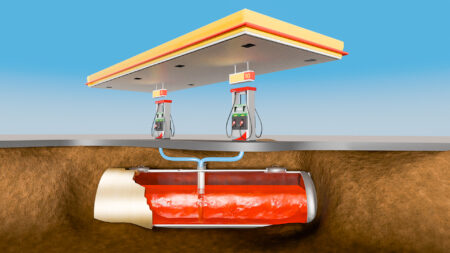In November 2019, this Chinese rocket lifted off from XiChang, carrying two navigation satellites into orbit. After the rocket’s first stage did its job, it fell back to Earth and landed right on top of someone’s house. Not only did this destroy the house, but the yellow smoke coming out of the rocket filled the air with extremely toxic gas.
For China, this is a relatively common sight. Many rocket parts have fallen onto villages and crashed straight through people’s houses, as a result of China’s carelessness. But in reality, space debris is always falling back to Earth. And although most of the world tries to keep it away from humans, that doesn’t always happen.

SpaceX space debris
In 2015, SpaceX shared this awesome GoPro footage from inside one of their fairings as it tumbled back to Earth. But back then, fairings weren’t being recovered. So how did they get this stunning footage back?
Well, it turns out this fairing went on a little journey once the cameras had cut out. After crashing into the ocean, this piece of debris managed to float all the way to the Bahamas, where it washed up on the tiny island of Elbow Cay.
Three businessmen who were there on vacation discovered the debris and quickly identified it as part of a SpaceX rocket. After contacting Musk on Twitter, the three guys agreed to return the GoPro and the data recorder back to SpaceX. But sometimes, space debris causes a much more serious problem.
In 1978, a 4 tonne nuclear powered Soviet satellite came crashing back down to Earth, carrying around 50kg of enriched Uranium with it. This scattered radioactive debris all across a large area in Northern Canada.
Some pieces had enough radiation to actually kill a human with only a few hours of contact. So in order to clean up the mess, Canada gathered a search team equipped with airplanes and helicopters – and set up ‘Operation Morning Light’.

The search team went out into the -40 degree tundra to identify and clean up every single piece of debris from the satellite. This search lasted for several months and by the end of it, they had spent a total of 6 million dollars.
And so, Canada sent a bill to the Soviets – who eventually only paid for half of it. This is the only case where a country had to actually file a liability claim to another country. But isn’t space junk meant to be dropped into the Ocean? And who owns the debris if it lands on the ground?
There’s no doubt that space debris is a huge problem. There are millions of pieces of space debris surrounding our Earth, from old satellites all the way down to flecks of paint. There’s even a decent amount of urine up there, since astronauts used to dump it outside their spacecraft before it could be recycled into drinking water.
But when it comes to objects making it all the way to the ground, we only need to worry about the really large pieces, since the small ones will burn up in the atmosphere. For that, we use the Space Surveillance Network, which uses an array of telescopes around the world to track and catalog space debris. It’s currently tracking over 27,000 pieces of debris, all of which are larger than a baseball.
The thing is, most of these objects don’t have any way of controlling themselves, and so predicting where and when they will reenter is very difficult. But what happens if the debris lands on your property?
Just a few months ago, a loud bang was heard over Western Australia – and soon after, this enormous chunk of metal was found sticking out of the ground on a man’s farm. This 30kg object turned out to be a piece of SpaceX’s Dragon capsule. This piece was so large that simply removing it from the ground would be a big challenge. But who owns it at this point? SpaceX or the farmer?

Well thanks to the Outer Space Treaty of 1967, SpaceX still owns this piece of debris, unless they specifically state that they don’t want it back. Sometimes, rocket companies like to analyze their debris, since it can teach them about how their spacecraft broke apart and what it went through during reentry.
When this happens, it’s up to the country it landed in to collect the debris and return it to its owner. Usually though, space companies don’t want their debris back – and so whoever found it, gets to keep it.
In this case, the farmers could end up making a decent amount of money, by selling parts of the debris online. If no one wants it, the local authorities will clean it up and send a bill to SpaceX. But why didn’t this one land in the ocean?
Before the Dragon capsule performs its deorbit burn, the trunk section is ditched and left in orbit until it eventually sinks low enough to burn up in the atmosphere. After spending an entire year in space and completing hundreds of orbits, astronomers had no way of knowing exactly where it would reenter.
All they had was a rough prediction that said it would come down somewhere along this line. In the end, this is where it landed. But what if a piece of debris ended up killing someone?
The number of rocket launches every year has just reached an all-time high. But what’s even more incredible is the number of satellites in orbit, which has grown exponentially in the last few years.
Scientists have calculated that there’s now a 10% chance that someone will get hit by a piece of debris in the next decade. But in fact, this has already happened. In 1997 a woman from Oklahoma was out walking in a park when she saw bright lights streaking across the sky.
Half an hour later, she was struck by a piece of metal that fell from the sky. It turned out to be from a Delta 2 rocket, which she just saw reentering the atmosphere. Luckily, the piece was so thin and light that its speed was very low when it hit her. This was the first and only known case of rocket debris hitting a human.
In many ways, some space fans might see debris falling near them as lucky instead of unlucky. When Starship SN11 blew up in the sky, it caused thousands of pieces of debris to rain down over Boca Chica. Some parts managed to float 7km down range, where they were picked up by local spectators.

Many of these parts even started to show up on eBay, where one guy made over 1,000 dollars selling metal scraps and heat shield tiles. Although SpaceX almost certainly wanted these pieces back, for that guy, it was just a good day’s work with a metal detector.
References













I don’t think the title of your article matches the content lol. Just kidding, mainly because I had some doubts after reading the article. https://www.binance.info/it/join?ref=S5H7X3LP
Thank you for your sharing. I am worried that I lack creative ideas. It is your article that makes me full of hope. Thank you. But, I have a question, can you help me?
Your article helped me a lot, is there any more related content? Thanks!
Thanks for sharing. I read many of your blog posts, cool, your blog is very good.